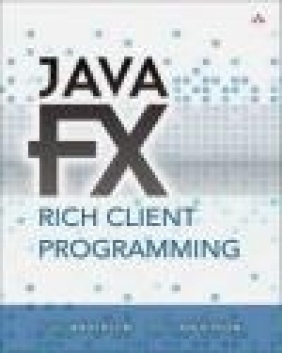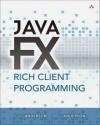JavaFXRich Client Programming on the Netbeans Platform
Paul Anderson, Gail Anderson
JavaFXRich Client Programming on the Netbeans Platform
Paul Anderson, Gail Anderson
- Producent: Addison Wesley Publishing Company
- Rok produkcji: 2014
- ISBN: 9780321927712
- Ilość stron: 928
- Oprawa: Miękka
Niedostępna
Opis: JavaFXRich Client Programming on the Netbeans Platform - Paul Anderson, Gail Anderson
JavaFX is a state-of-the-art graphics toolkit that is now built into Java and can be easily integrated with the NetBeans Platform. With JavaFX, you can create advanced user interfaces, manipulate media, generate graphical effects and animations, and much more. The NetBeans Platform provides a framework for building robust, modular applications with long life expectancies. Together, JavaFX and the NetBeans Platform provide the basis for creating visually appealing, industrial-strength applications. Focusing on JavaFX as the front end for rich client applications, this guide's examples cover JavaFX 8 with the NetBeans Platform, NetBeans IDE, and Java 8. Gail and Paul Anderson fully explain JavaFX and its relationship with the NetBeans Platform architecture, and systematically show Java developers how to use them together effectively. Each concept and technique is supported by clearly written code examples, proven through extensive classroom teaching. Coverage includes * Background basics with Java, JavaFX, and UI events* Building loosely coupled applications* NetBeans Platform Modules and Lookup* NetBeans Platform Nodes, Explorer Views, and Actions* Building CRUD-based applications* Integrating JavaFX with a Swing-based framework* Using JavaFX Charts with the NetBeans Platform* Using the NetBeans Platform File System and Data System* Keeping the UI responsiveForeword xvii Preface xix About the Authors xxiii Chapter 1: A Tour of the NetBeans Platform 1 What You Will Learn 1 1.1 Background Basics 2 1.2 The NetBeans Platform: The Big Picture 3 1.3 FamilyTreeApp Reference Application 10 1.4 Documentation 17 1.5 How to Get Java and the NetBeans Platform Software 17 1.6 Example Software Bundle 18 1.7 Key Point Summary 18 Chapter 2: Background Basics 19 What You Will Learn 20 2.1 JavaBeans and Properties 20 2.2 Lambda Expressions 38 2.3 Swing Basics 40 2.4 Improving the User Experience 63 2.5 Concurrency and Thread Safety 68 2.6 Swing Background Tasks 73 2.7 Key Point Summary 80 Chapter 3: Introduction to JavaFX 83 What You Will Learn 83 3.1 What Is JavaFX? 84 3.2 Building JavaFX Programs 87 3.3 JavaFX Properties 103 3.4 Putting It All Together 120 3.5 Key Point Summary 128 Chapter 4: Working with JavaFX 131 What You Will Learn 131 4.1 Creating JavaFX Properties 132 4.2 Using JavaFX Properties in a JavaFX Application 139 4.3 Observable Collections 148 4.4 JavaFX Applications 153 4.5 Concurrency and Thread Safety 172 4.6 JavaFX Background Tasks 176 4.7 Monitoring Background Tasks 182 4.8 Key Point Summary 195 Chapter 5: A Taste of Modularity 199 What You Will Learn 199 5.1 Modular Architecture 199 5.2 Creating a NetBeans Platform Application 203 5.3 Creating Modules 208 5.4 Configuring a Module with Public Packages 211 5.5 Registering a Service Provider 214 5.6 Configuring a Window for Selection 219 5.7 Configuring a Window with Form Editing 231 5.8 Module Life Cycle Annotations 242 5.9 What We Know So Far 244 5.10 Key Point Summary 245 Chapter 6: JavaFX Integration 249 What You Will Learn 249 6.1 JavaFX and the NetBeans Platform 250 6.2 Communication Strategies 261 6.3 Integrating with the NetBeans Platform 265 6.4 Key Point Summary 289 Chapter 7: Nodes and Explorer Views 291 What You Will Learn 291 7.1 The NetBeans Model View Controller 292 7.2 Nodes 293 7.3 Explorer Views 323 7.4 Creating a Selection History Feature 332 7.5 Key Point Summary 338 Chapter 8: NetBeans Platform Window System 341 What You Will Learn 342 8.1 Window Framework Overview 342 8.2 TopComponent Basics 352 8.3 TopComponent Persistence 361 8.4 TopComponent Client Properties 363 8.5 Creating Non-Singleton TopComponents 364 8.6 Window System Life Cycle Management 369 8.7 TopComponent Modes 376 8.8 Window Groups 381 8.9 Window Layout 387 8.10 Window Layout Roles 401 8.11 Key Point Summary 410 Chapter 9: Action Framework 413 What You Will Learn 413 9.1 Type of Actions 414 Always-Enabled Actions 414 9.2 Actions and Lookup 421 9.3 Editing the Node Hierarchy 444 9.4 Inter-Window Drag and Drop 458 9.5 Key Point Summary 468 Chapter 10: Building a CRUD Application 471 What You Will Learn 471 10.1 Create-Read-Update-Delete Application 472 10.2 Using CRUD with a Database 501 10.3 Concurrency in the FamilyTreeApp Application 516 10.4 Key Point Summary 523 Chapter 11: Dialogs 525 What You Will Learn 525 11.1 Dialog Overview 526 11.2 Standard Dialogs 527 11.3 Customizing Standard Dialogs 531 11.4 Custom Dialogs 533 11.5 Custom Login Dialog 539 11.6 Putting It All Together 544 11.7 Key Point Summary 548 Chapter 12: Wizards 551 What You Will Learn 551 12.1 Wizard Overview 552 12.2 The Wizard Wizard 554 12.3 Wizard Input 561 12.4 Wizard Validation 565 12.5 Simple Validation API 577 12.6 Finishing Early Option 587 12.7 Asynchronous Validation 592 12.8 Dynamic Sequence Wizards 598 12.9 Wizard Instantiating Iterators 614 12.10 Key Point Summary 620 Chapter 13: File System 623 What You Will Learn 623 13.1 File System API 624 13.2 The File System API Overview 624 13.3 Monitoring File Changes 636 13.4 Including a File with Your Application 649 13.5 The Layer File and System FileSystem 654 13.6 Key Point Summary 668 Chapter 14: Data System 671 What You Will Learn 671 14.1 Data System API Overview 672 14.2 Creating a New File Type 678 14.3 Working with MultiView Windows 697 14.4 Creating an XML-Based File Type 721 14.5 Key Point Summary 740 Chapter 15: JavaFX Charts 743 What You Will Learn 743 15.1 JavaFX Charts and the NetBeans Platform 744 15.2 Introducing JavaFX Charts 759 15.3 Data Visualization with JavaFX Charts 764 15.4 Adding Behaviors to JavaFX Charts 781 15.5 Saving Charts 789 15.6 Key Point Summary 795 Chapter 16: Using Web Services 799 What You Will Learn 799 16.1 RESTful Web Services and the NetBeans Platform 800 16.2 Creating RESTful Web Services 802 16.3 A Java Application Web Service Client 810 16.4 RESTful Web Services in a NetBeans Platform Application 817 16.5 Key Point Summary 845 Chapter 17: Branding, Distribution, and Internationalization 847 What You Will Learn 847 17.1 What Is Branding? 848 17.2 Application Updates 857 17.3 Application Distribution 864 17.4 Application Internationalization 868 17.5 Key Point Summary 883 Index 885
Szczegóły: JavaFXRich Client Programming on the Netbeans Platform - Paul Anderson, Gail Anderson
Tytuł: JavaFXRich Client Programming on the Netbeans Platform
Autor: Paul Anderson, Gail Anderson
Producent: Addison Wesley Publishing Company
ISBN: 9780321927712
Rok produkcji: 2014
Ilość stron: 928
Oprawa: Miękka
Waga: 1.19 kg




















